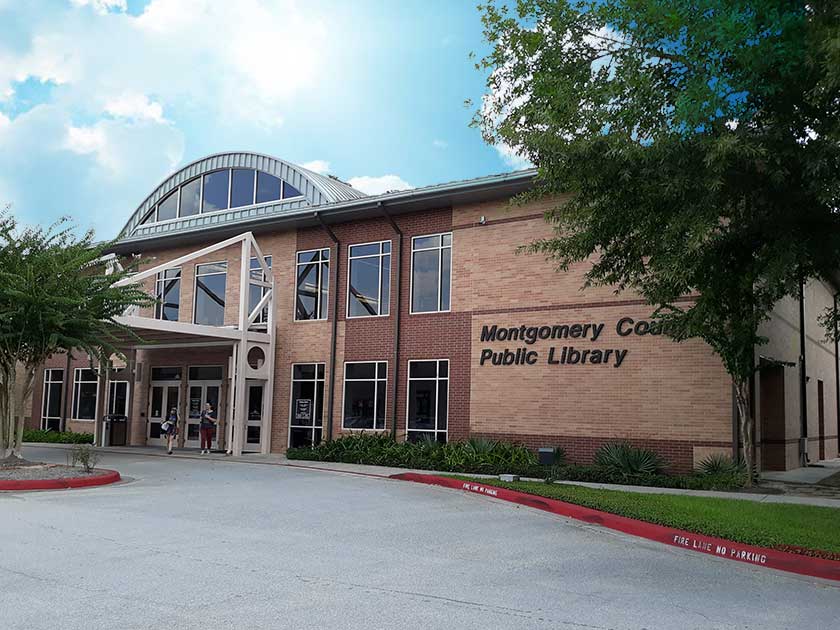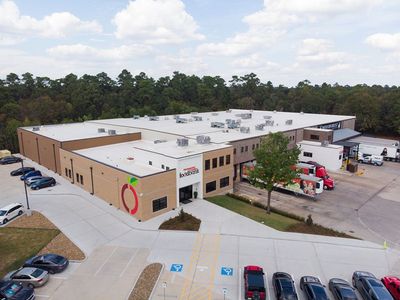- Sections :
- Crime & Public Safety
- Restaurants & Food
- Sports
- More
Categories
The State of Public Libraries in The Woodlands and Beyond

THE WOODLANDS, TX -- Think back: when was the last time you visited a public library? If you haven’t visited a library in person in the last 12 months, you’re not alone — according to a recent Pew Research study, 56% of American adults are in the same boat. In fact, in-person library visits have steadily declined in the last decade. To keep pace with rapidly changing technology and the needs of their communities, libraries across the country and the world are working tirelessly to adapt to the new digital ecosystem.
To get a better sense of how this reorientation is actually handled on the ground, we spoke with Lynn Garcia, manager at the South County Regional Library here in The Woodlands. Her office is a glass-paned room with a good view of the main floor and festooned with dozens of LEGO figures, all recognizable book, film, and television characters. On the little round table nearby several larger figures were in the assembly process, including a large castle harboring ghosts and ghouls, a Mystery Machine still awaiting its emancipation from the cardboard box next door. The space is reminiscent of a fishbowl, if the fish had really good taste in pop culture LEGO figurines.
“These are all mini figures that I’ve collected for several years,” Lynn said, “I’ve put them up for the kids to look at and they really enjoy it, they think it’s a playroom in here.” Lynn started off in corporate office management, but decided upon getting a master’s degree to make the switch to libraries because, of course, “everybody loves libraries.” Despite Lynn’s love of libraries and the value they bring to the community, she feels, as do many, that they are underutilized.
The Pew Research study indicates that total library usage has declined in recent years, but the falling usage is mitigated by the increasing online presence of library resources. For instance, according to the report, 90% of American local libraries offer e-book lending. However, 38% of Americans are unaware that their local branch provides this service; Montgomery County libraries are no different. Like many library systems around the country, Montgomery County public libraries maintain a collection of volumes available for electronic checkout for those with e-readers; books, newspapers, and magazines are made available through a number of online platforms and the system makes the hassle of having to physically check items in and out of the library obsolete.
“Oh I didn’t know they still had libraries!” is a refrain Lynn has heard more than a few times. “But people forget that we bring the internet into the library. We have computers here, we have computer classes that are free, we have electronic databases.” Public libraries across the board have experienced significant growth in programming since 2012. According to a report from the American Library Association, the number of public programs offered per capita has jumped 27.5%, while the number of programs attended per capita has risen 16.9%.
Some of the programs currently offered by the South County branch include conversation club, where regular meetings are facilitated by an ESL teacher and participants may practice their Spanish or English in a supportive environment, a gardening seminar led by a master gardener with Texas Agrilife, evening computer classes, Walking Book Club (now that the weather has begun to change), a program wherein children practice their reading skills by narrating books to trained support dogs, and at the direction of a new young adult program, an anime club.
According to Lynn, there isn’t a specific type of library patron — families with children are regular patrons, of course, but the space is frequented by retirees and students alike. More than anything, the goal is to provide a quiet, well-equipped space for community members to work, learn, and enjoy themselves. Study rooms get booked during finals and periodicals are in high demand in the mornings.
A study conducted by the Institute of Museum and Library Sciences revealed that as investments, such as revenue, staffing, and programs, increased so did critical use measures, like visitation and circulation. In the same way, as investments were reduced, mostly in reaction to post-recessionary budgetary reductions, there was a decrease in library use across the board. Additionally, even as investments declined, decreases in use did not drop by the same magnitude. People continued to use their local public libraries for access to books and information and for gathering as a community. In other words, usage tracks funding, though it’s not one-to-one.
Of course books — and funding — are not always available as needed; that comes with the territory. Montgomery County libraries are, according to Lynn, generally well-funded, but the system is always grateful to the volunteers and donors that make an expansive public service really possible. Evidently children’s books, which experience high demand and high abuse (unsurprising for anyone who’s encountered a literate but rambunctious child), are the hardest to keep in stock. Libraries like South County purchase books with high-quality bindings that are able to withstand 150 or more checkouts, but it’s still hard to keep copies of Captain Underpants on the shelf. The rate at which copies of books become unusable is high enough that for South County, book donations are a godsend..
Our local library continues to see lots of use. According to Lynn, more than 650 new library cards were activated in June 2019 as families moved into the area in between school years. Keeping abreast of technological advancements has leant new life to the system, and more than a terabyte of internet usage was registered at the location in the same month.
“My favorite part is why I got into libraries to begin with — the ability to teach somebody how to do something and not just do it for them, but to teach them how to do something — access a database, use a program — to pass on knowledge is always the best part. And, of course, introducing someone to a new book is always fun,” Lynn said. One can only hope that one of the great bastions of community life is able to remain afloat as social patterns and technological needs continue to change rapidly, and for the foreseeable future.
To get a better sense of how this reorientation is actually handled on the ground, we spoke with Lynn Garcia, manager at the South County Regional Library here in The Woodlands. Her office is a glass-paned room with a good view of the main floor and festooned with dozens of LEGO figures, all recognizable book, film, and television characters. On the little round table nearby several larger figures were in the assembly process, including a large castle harboring ghosts and ghouls, a Mystery Machine still awaiting its emancipation from the cardboard box next door. The space is reminiscent of a fishbowl, if the fish had really good taste in pop culture LEGO figurines.
“These are all mini figures that I’ve collected for several years,” Lynn said, “I’ve put them up for the kids to look at and they really enjoy it, they think it’s a playroom in here.” Lynn started off in corporate office management, but decided upon getting a master’s degree to make the switch to libraries because, of course, “everybody loves libraries.” Despite Lynn’s love of libraries and the value they bring to the community, she feels, as do many, that they are underutilized.
The Pew Research study indicates that total library usage has declined in recent years, but the falling usage is mitigated by the increasing online presence of library resources. For instance, according to the report, 90% of American local libraries offer e-book lending. However, 38% of Americans are unaware that their local branch provides this service; Montgomery County libraries are no different. Like many library systems around the country, Montgomery County public libraries maintain a collection of volumes available for electronic checkout for those with e-readers; books, newspapers, and magazines are made available through a number of online platforms and the system makes the hassle of having to physically check items in and out of the library obsolete.
“Oh I didn’t know they still had libraries!” is a refrain Lynn has heard more than a few times. “But people forget that we bring the internet into the library. We have computers here, we have computer classes that are free, we have electronic databases.” Public libraries across the board have experienced significant growth in programming since 2012. According to a report from the American Library Association, the number of public programs offered per capita has jumped 27.5%, while the number of programs attended per capita has risen 16.9%.
Some of the programs currently offered by the South County branch include conversation club, where regular meetings are facilitated by an ESL teacher and participants may practice their Spanish or English in a supportive environment, a gardening seminar led by a master gardener with Texas Agrilife, evening computer classes, Walking Book Club (now that the weather has begun to change), a program wherein children practice their reading skills by narrating books to trained support dogs, and at the direction of a new young adult program, an anime club.
According to Lynn, there isn’t a specific type of library patron — families with children are regular patrons, of course, but the space is frequented by retirees and students alike. More than anything, the goal is to provide a quiet, well-equipped space for community members to work, learn, and enjoy themselves. Study rooms get booked during finals and periodicals are in high demand in the mornings.
A study conducted by the Institute of Museum and Library Sciences revealed that as investments, such as revenue, staffing, and programs, increased so did critical use measures, like visitation and circulation. In the same way, as investments were reduced, mostly in reaction to post-recessionary budgetary reductions, there was a decrease in library use across the board. Additionally, even as investments declined, decreases in use did not drop by the same magnitude. People continued to use their local public libraries for access to books and information and for gathering as a community. In other words, usage tracks funding, though it’s not one-to-one.
Of course books — and funding — are not always available as needed; that comes with the territory. Montgomery County libraries are, according to Lynn, generally well-funded, but the system is always grateful to the volunteers and donors that make an expansive public service really possible. Evidently children’s books, which experience high demand and high abuse (unsurprising for anyone who’s encountered a literate but rambunctious child), are the hardest to keep in stock. Libraries like South County purchase books with high-quality bindings that are able to withstand 150 or more checkouts, but it’s still hard to keep copies of Captain Underpants on the shelf. The rate at which copies of books become unusable is high enough that for South County, book donations are a godsend..
Our local library continues to see lots of use. According to Lynn, more than 650 new library cards were activated in June 2019 as families moved into the area in between school years. Keeping abreast of technological advancements has leant new life to the system, and more than a terabyte of internet usage was registered at the location in the same month.
“My favorite part is why I got into libraries to begin with — the ability to teach somebody how to do something and not just do it for them, but to teach them how to do something — access a database, use a program — to pass on knowledge is always the best part. And, of course, introducing someone to a new book is always fun,” Lynn said. One can only hope that one of the great bastions of community life is able to remain afloat as social patterns and technological needs continue to change rapidly, and for the foreseeable future.
Comments •

















